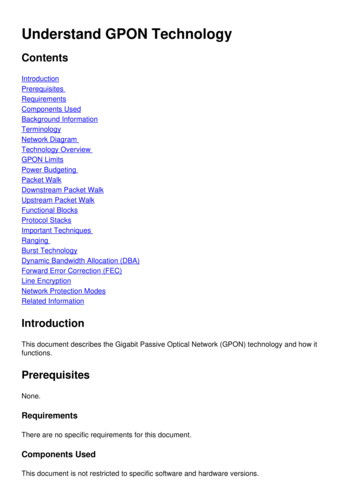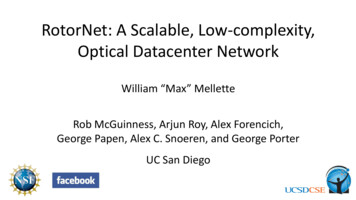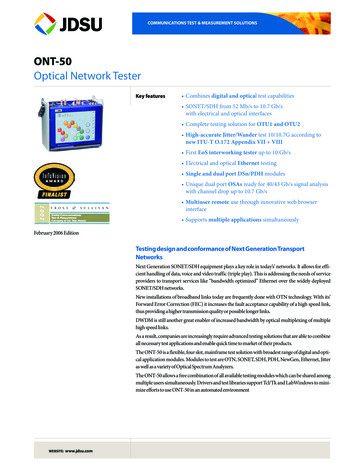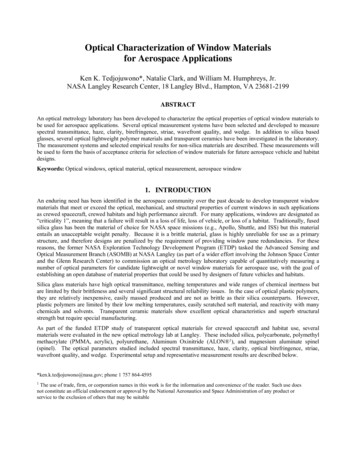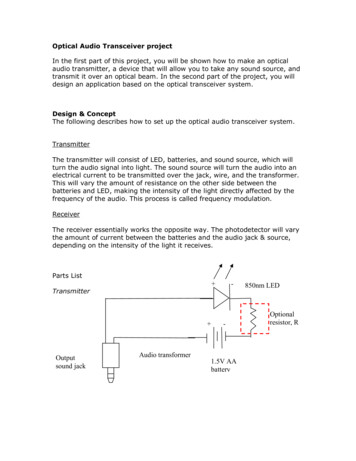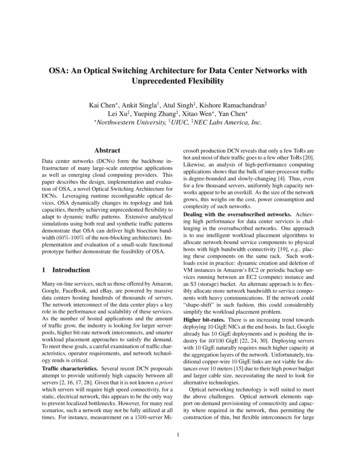
Transcription
OSA: An Optical Switching Architecture for Data Center Networks withUnprecedented FlexibilityKai Chen , Ankit Singla† , Atul Singh‡ , Kishore Ramachandran‡Lei Xu‡ , Yueping Zhang‡ , Xitao Wen , Yan Chen Northwestern University, † UIUC, ‡ NEC Labs America, Inc.Abstractcrosoft production DCN reveals that only a few ToRs arehot and most of their traffic goes to a few other ToRs [20].Likewise, an analysis of high-performance computingapplications shows that the bulk of inter-processor trafficis degree-bounded and slowly-changing [4]. Thus, evenfor a few thousand servers, uniformly high capacity networks appear to be an overkill. As the size of the networkgrows, this weighs on the cost, power consumption andcomplexity of such networks.Dealing with the oversubscribed networks. Achieving high performance for data center services is challenging in the oversubscribed networks. One approachis to use intelligent workload placement algorithms toallocate network-bound service components to physicalhosts with high bandwidth connectivity [19], e.g., placing these components on the same rack. Such workloads exist in practice: dynamic creation and deletion ofVM instances in Amazon’s EC2 or periodic backup services running between an EC2 (compute) instance andan S3 (storage) bucket. An alternate approach is to flexibly allocate more network bandwidth to service components with heavy communications. If the network could“shape-shift” in such fashion, this could considerablysimplify the workload placement problem.Higher bit-rates. There is an increasing trend towardsdeploying 10 GigE NICs at the end hosts. In fact, Googlealready has 10 GigE deployments and is pushing the industry for 40/100 GigE [22, 24, 30]. Deploying serverswith 10 GigE naturally requires much higher capacity atthe aggregation layers of the network. Unfortunately, traditional copper-wire 10 GigE links are not viable for distances over 10 meters [15] due to their high power budgetand larger cable size, necessitating the need to look foralternative technologies.Optical networking technology is well suited to meetthe above challenges. Optical network elements support on-demand provisioning of connectivity and capacity where required in the network, thus permitting theconstruction of thin, but flexible interconnects for largeData center networks (DCNs) form the backbone infrastructure of many large-scale enterprise applicationsas well as emerging cloud computing providers. Thispaper describes the design, implementation and evaluation of OSA, a novel Optical Switching Architecture forDCNs. Leveraging runtime reconfigurable optical devices, OSA dynamically changes its topology and linkcapacities, thereby achieving unprecedented flexibility toadapt to dynamic traffic patterns. Extensive analyticalsimulations using both real and synthetic traffic patternsdemonstrate that OSA can deliver high bisection bandwidth (60%-100% of the non-blocking architecture). Implementation and evaluation of a small-scale functionalprototype further demonstrate the feasibility of OSA.1IntroductionMany on-line services, such as those offered by Amazon,Google, FaceBook, and eBay, are powered by massivedata centers hosting hundreds of thousands of servers.The network interconnect of the data center plays a keyrole in the performance and scalability of these services.As the number of hosted applications and the amountof traffic grow, the industry is looking for larger serverpools, higher bit-rate network interconnects, and smarterworkload placement approaches to satisfy the demand.To meet these goals, a careful examination of traffic characteristics, operator requirements, and network technology rends is critical.Traffic characteristics. Several recent DCN proposalsattempt to provide uniformly high capacity between allservers [2, 16, 17, 28]. Given that it is not known a prioriwhich servers will require high speed connectivity, for astatic, electrical network, this appears to be the only wayto prevent localized bottlenecks. However, for many realscenarios, such a network may not be fully utilized at alltimes. For instance, measurement on a 1500-server Mi1
server pools. Optical links can support higher bit-ratesover longer distances using less power than copper cables. Moreover, optical switches run cooler than electrical ones [11], resulting in lower heat dissipation andcheaper cooling cost. The long-term advantage of opticsin DCNs has been noted in the industry [1, 11].Recent efforts in c-Through [35] and Helios [15] provide a promising direction to exploit optical networkingtechnology (e.g., one-hop high-capacity optical circuits)for building DCNs. Following this trailblazing research,we present OSA, a novel Optical Switching Architecture for DCNs. OSA achieves high flexibility by leveraging and extending the techniques devised by previouswork, and further combining them with novel techniquesof its own. Similar to the previous work, OSA leverages reconfigurability of optical devices to dynamicallyset up one-hop optical circuits. Then, OSA employs thenovel hop-by-hop stitching of multiple optical links toprovide all-to-all connectivity for mice flows and burstycommunications, and also to handle workloads involvinghigh fan-in/out hotspots [18] that the existing one-hopelectrical/optical architectures cannot address efficientlyvia their optical interconnects1 . Further, OSA dynamically adjusts the capacities on the optical links to satisfy changing traffic demand at a finer granularity. Additionally, to make efficient use of expensive optical ports,OSA introduces Circulator (Sec. 2.2), a bi-directionalityenabling component for simultaneous transmission inboth directions over the same circuit, which potentiallydoubles the usage of MEMS ports.Overall, the highlights of this paper are as follows.suggest that OSA-2560 can deliver high bisection bandwidth that is 60%-100% of the non-blocking networkand outperform the hybrid structures by 80%-250% forboth real and synthetic traffic patterns. Our analysis(Sec.3.3) shows that OSA incurs lower cost ( 38%),lower ( 37%) power consumption, and one order ofmagnitude simpler cabling complexity compared to anon-blocking Fattree [2] connecting a similar number ofservers. Furthermore, compared with the hybrid structures, OSA has similar cost but consumes slightly lesspower. We believe that for data centers that expectskewed traffic demands, OSA provides a compellingtradeoff between cost, complexity and performance.An implementation of OSA prototype. We build asmall-scale 8-rack OSA prototype with real optical devices. Through this testbed, we evaluate the performanceof OSA with all software and hardware overheads. Ourresults show that OSA can quickly adapt the topologyand link capacities to meet the changing traffic patterns,and that it achieves nearly 60% of non-blocking bandwidth in the all-to-all communication. We further examine the impact of OSA design on bulk data transfer andmice flows, and find that the overhead introduced by hopby-hop routing on mice flows is small: a 2 ms additionallatency for a 7-hop routing with full background traffic.We also measure the device characteristics of the optical equipment, evaluate the impact of multi-hop opticalelectrical-optical (O-E-O) conversion, and discuss ourexperience building and evaluating the OSA prototype.Limitations. OSA, in its current form, has limitations.Small flows, especially those latency-sensitive ones, mayincur non-trivial penalty due to reconfiguration delays( 10ms). While the fraction of such affected flows issmall (Sec. 7), we propose multiple avenues to solve thischallenge. The second challenge is to scale OSA froma container-size to a larger date center consisting of tensto hundreds of thousands of servers. This requires nontrivial efforts in both architecture and management design, and is left as part of our ongoing investigation. Inthis paper, we describe OSA that is designed to connectfew thousands of servers in a container.Roadmap. In Sec. 2, we discuss the idea of OSA’s unprecedented flexibility, followed by background on optical technologies for OSA. Then we describe OSA architecture (Sec. 3) and its algorithm design (Sec. 4) inresponse to traffic patterns. In Sec. 5 and Sec. 6, we evaluate OSA via extensive simulations and implementationrespectively. We discuss some design issues and relatedwork to OSA in Sec. 7 before concluding in Sec. 8.A flexible DCN architecture. Given a number N ofTop-of-Rack (ToR) switches and a design-time-fixed parameter k, OSA can assume any k-regular topology overthe N ToRs. To illustrate how many options this givesus, consider that for just N 20, there are over 12 billion (non-isomorphic) connected 4-regular graphs [25].In addition, OSA allows the capacity of each edge inthis k-regular topology to be varied from a few Gb/s toa few hundred Gb/s on-demand. Evaluation results inSec. 5.2.2 suggest an up to 150% and 50% performanceimprovement brought by flexible topology and flexiblelink capacity, respectively.An analysis of OSA-2560. We evaluate a particularinstance of container-size OSA architecture, OSA-2560(N 80, k 4), with 2560 servers via extensive simulations and analysis. Our evaluation results (Sec. 5.2)1 In the optical part of the existing hybrid electrical/optical architectures, one ToR only connects to one other ToR at a time. While itcan connect to different ToRs at different times, the switching latencywould be around 10 ms. As we will introduce, in OSA, one ToR canconnect to multiple ToRs simultaneously at a time, and more importantly, multi-hop connection exist between any pair of remote ToRs viahop-by-hop circuit stitching.2 Motivation and BackgroundWe first use a motivating example to show what kind offlexibility OSA delivers. Then, we introduce the optical2
HGEHFDAGCCAGHEFD1010101010HDFGCBEBABCDBC-band. For the purposes of our architecture, each wavelength is rate-limited by the electrical port it connects to.2. Wavelength Selective Switch (WSS): A WSS istypically a 1 N switch, consisting of one commonport and N wavelength ports. It partitions (runtimeconfigurable within a few ms) the set of wavelengthscoming in through the common port among the N wavelength ports. E.g., if the common port receives 80 wavelengths then it can route wavelengths 1–20 on port 1,wavelengths 30–40 and 77 on port 2, etc.3. Optical Switching Matrix (OSM): Most OSMmodules are bipartite N N matrix where any inputport can be connected to any one of the output ports.The most popular OSM technology uses Micro-ElectroMechanical Switch, or MEMS. It can reconfigure to anew input/output matching within 10ms [33] by mechanically adjusting a microscopic array of mirrors. A fewhundred ports are common for commercial products, and 1000 for research prototypes [14]. The current commercially available OSM modules are typically obliviousto the wavelengths carried across it. We use MEMS andOSM interchangeably.4. Optical Circulators: Circulators enable bidirectionaloptical transmission over a fiber, allowing more efficientuse of the ports of optical switches. An optical circulator is a three-port device: one port is a shared fiber orswitching port, and the other two ports serve as send andreceive ports.5. Optical Transceivers: Optical transceivers can beof two types: coarse WDM (CWDM) and dense WDM(DWDM). We use DWDM-based transceivers, whichsupport higher bit-rates and more wavelength channelsin a single piece of fiber compared to CWDM.DFABCFBGHEGD1010102010AEBFigure 1: OSA adapts topology and link capacities to thechanging traffic demands.technologies that make OSA possible.2.1A Motivating ExampleWe discuss the utility of a flexible network using the simple hypothetical example in Fig. 1. On the left is a hypercube connecting 8 ToRs using 10G links. The trafficdemand is shown in the bottom-left of Fig. 1. For thisdemand, no matter what routing paths are used on thishypercube, at least one link will be congested. One wayto tackle this congestion is to reconnect the ToRs usinga different topology (Fig. 1, bottom-center). In the newtopology, all the communicating ToR pairs are directlyconnected and their demand can be perfectly satisfied.Now, suppose the traffic demand changes (Fig. 1,bottom-right) with a new (highlighted) entry replacing anold one. If no adjustment is made, at least one link willface congestion. With the shortest path routing, F Gwill be that link. In this scenario, one solution to avoidcongestion is to increase the capacity of the F G to20G at the expense of decreasing capacity of link F Dand link G C to 0. Critically, note that in all threetopologies, the degree and the capacity of nodes remainthe same, i.e., 3 and 30G respectively.As above, OSA’s flexibility lies in its flexible topology and link capacity. In the absence of such flexibility,the above example would require additional links and capacities to handle both traffic patterns. More generally,a large variety of traffic patterns would necessitate 1:1over-subscription (i.e., non-blocking) network construction. OSA avoids the cost of constructing a non-blockingnetwork while still providing equivalent performance forvarying traffic patterns.2.23 OSA ArchitectureIn this section, we introduce how OSA2 is built from theabove described optical technologies. Our current designtargets container-size DCNs.3.1 Building BlocksFlexible topology. OSA achieves flexible topology viaexploiting the reconfigurability of MEMS. Say we startby connecting each of N ToRs to one port on an N -portMEMS. Given the MEMS bipartite port-matching, thisimplies that every ToR can only communicate with oneother ToR at any instant, leaving the ToR level graph disconnected. If we connect N/k ToRs to k ports each atthe MEMS, each ToR can communicate with k ToRs simultaneously. Here, k 1 is the degree of a ToR, notOptical TechnologiesWe now discuss the optical networking technologies thatenable the above flexibility.1. Wavelength Division Multiplexing (WDM): Depending on the channel spacing, using WDM, typically40 or up to 100 channels or wavelengths can be transmitted over a single piece of fiber in the conventional or2 Wepresented a preliminary design of OSA in an earlier workshoppaper [32].3
its port count, in the ToR graph. The configuration of theMEMS determines which set of ToRs are connected; andOSA must ensure that the ToR graph is connected whenconfiguring the MEMS.Given a ToR graph connected by optical circuitsthrough the MEMS, we use hop-by-hop stitching of suchcircuits to achieve network-wide connectivity. To reachremote ToRs that are not directly connected, a ToR usesone of its k connections. This first-hop ToR receives thetransmission over fiber, converts it to electrical signals,reads the packet header, and routes it towards the destination. At each hop, every packet is converted fromoptics to electronics and then back to optics (O-E-O)and switching at the ToR. Pure O-E-O conversion can bedone in sub-nanoseconds [21]. Note that at any port, theaggregate transit, incoming and outgoing traffic cannotexceed the port’s capacity in each direction. So, highvolume connections must use a minimal number of hops.OSA should manage the topology to adhere to this requirement. Evaluation in Sec. 6 quantifies the overhead(both O-E-O and switching) of hop-by-hop routing.Flexible link capacity. Every ToR has degree k. If eachedge had fixed capacity, multiple edges may need to beused for this ToR to communicate with another ToR at arate higher than a single edge supports. To overcome thisproblem, OSA combines the capability of optical fibersto carry multiple wavelengths at the same time (WDM)with the dynamic reconfigurability of the WSS. Consequently, a ToR is connected to the MEMS through a multiplexer and a WSS unit.Specifically, suppose ToR A wants to communicatewith ToR B using w times the line speed of a singleport. The ToR will use w ports, each associated witha (unique) wavelength, to serve this request. WDM enables these w wavelengths, together with the rest fromthis ToR, to be multiplexed into one optical fiber thatfeeds the WSS. The WSS splits these w wavelengths tothe appropriate MEMS port which has a circuit to ToRB (doing likewise for k 1 other wavelengths). Thus, aw (line-speed) capacity circuit is set up from A to B,at runtime. By varying the value of w for every MEMScircuit, OSA achieves dynamic capacity for every edge.We note that a fiber cannot carry two channels over thesame wavelength in the same direction. Moreover, to enable a ToR pair to communicate using all available wavelengths, we require that each ToR port (facing the optical interconnect) is assigned a wavelength unique acrossports at this ToR. The same wavelength is used to receivetraffic as well: each port thus sends and receives trafficat one fixed wavelength. The same set of wavelengthsis recycled across ToRs. This allows all wavelengths atone ToR to be multiplexed and delivered after demultiplexing to individual ports at the destination ToR. Thiswavelength-port association is a design time decision.Figure 2: The overall OSA architecture; detailed structure is shown only for ToR1 for clarity.Efficient port usage. To make full use of the MEMSports, we desire that each circuit over the MEMS be bidirectional. For this, we use optical circulators betweenthe ToR and the MEMS ports. A circulator connects thesend channel of the transceiver from a ToR to the MEMS(after the channel has passed through the WSS). It simultaneously delivers the traffic incoming towards a ToRfrom the MEMS, to this ToR. Note that even though theMEMS edges are bidirectional, the capacities of the twodirections are independent of each other.3.2 Putting it All Together: OSA-2560Fig. 2 illustrates the general OSA architecture. We nowdiscuss one specific instantiation, OSA-2560, with N 80 ToRs, W 32 wavelengths and ToR degree k 4using a 320-port MEMS to support 2560 servers.Each ToR is a commodity electrical switch with 64 10GigE ports [7]. 32 of these ports are connected to servers,while the remaining face the optical interconnect. Eachport facing the optical interconnect has a transceiver associated with a fixed and unique wavelength for sendingand receiving data. The transceiver uses separate fibersto connect to the send and receive infrastructures.The send fiber from the transceivers from each of the32 ports at a ToR is connected to an optical multiplexer.The multiplexer feeds a 1 4 WSS. The WSS splits theset of 32 wavelengths it sees into 4 groups, each groupbeing transmitted on its own fiber. These fibers are connected to the MEMS via circulators to enable bidirectional communications. The 4 receive fibers from 4 circulators are connected to a power coupler (similar to amultiplexer, but simpler), which combines their wavelengths onto one fiber. This fiber feeds a demultiplexer,which splits each incoming wavelength to its associatedport on the ToR.We point out two key properties of the above interconnect. First, each ToR can communicate simultaneouslywith any 4 other ToRs. This implies that the MEMS configuration allows us to construct all possible 4-regular4
ElementToR (10G port)MEMSWSSTransceiver WElement WArchitecture KW% of –50%‡60%–100%‡100%Table 1: † Cost (USD) and power (Watt) per port for different elements, the values are from Helios [15].Table 2: Cost, power and performance for different network architectures to support 2560 servers with 10GigEports. (‡ For traffic patterns we evaluate in Sec. 5.)graphs among ToRs. Second, through WSS configuration, the capacity of each of these 4 links can be variedin {0, 10, 20, . . . , 320} Gbps. The MEMS and WSSconfigurations are decided by a central OSA manager.The manager estimates the traffic demand, calculates appropriate configurations, and pushes them to the MEMS,WSS units and ToRs. This requires direct, out-of-bandconnections between the manager and these components.Our use of such a central OSA manager is inspired bymany recent works [8, 15, 16, 28, 35] in the context ofDCNs given that a DCN is usually owned and operatedby a single organization.Furthermore, we choose k 4 for container-sizedDCNs because it is a tradeoff between the network sizeand performance. A larger k value can enable one ToR toconnect to more other ToRs simultaneously, thus achieving higher performance. However, given the fixed 320port MEMS, it also means that fewer ToRs (320/k) canbe supported. Our experiments with k 1, 2, 4, 8 indicate that k 4 can deliver considerable bisection bandwidth between thousands of servers.3.3Simplified model of the hybrid structure. Helios [15]and c-Through [35] are two well-known hybrid electrical/optical structures. The hybrid structure model weused here and in Sec. 5 is an abstract model that captureskey aspects of both. In this model, each ToR has connections to an electrical network and an optical network.The electrical network is a two or three tiered tree witha certain over-subscription ratio (8:1 for Table 2). In theoptical part, each ToR has only one optical link connecting to one other ToR, but this link is of unrestricted capacity. This hybrid structure costs USD 5.6M, consumes78KW and has 480 long fibers – 160 above the MUX inoptical part and 320 above the ToRs in electrical part.OSA. The total cost is approximately USD 5.6M, witha power consumption of 73KW. ToRs and transceiversare responsible for a large portion of the cost and powerbudget. Compared to the traditional architecture, the additional cost is mainly due to (DE)MUX and WSS units.The number of long fibers required by OSA is small –320 fibers above the circulator layer. The ToR to circulator connection is very short and can be packaged withthe ToR. OSA’s cost is similar to the hybrid structure butis 20% more expensive than the traditional structure4 ,however, it can dynamically adjust the bandwidth allocated to demanding flows. For all traffic demands weevaluated in Sec. 5, this enables OSA to achieve 60%100% of the non-blocking bisection bandwidth. Thepower consumption is nearly identical to that of the traditional oversubscribed network; this is because the totalnumber of electrical ports used in both architectures areidentical, and optical components add negligible power.Fattree. The cost and power of Fattree depends solelyon the number of ports needed: a Fattree topology withp port Ethernet switches can connect p3 /4 hosts with atotal of 5*p3 /4 ports. Note that for 10G port electricalswitches, optical transceiver for remote connection is anecessity. To connect 2560 servers, Fattree costs 14.6MUSD. The power consumption is 196KW. The numberof fibers required above the ToR layer is 5120. Fattreeis more expensive and consumes more power, because itAnalysisTable 1 lists the cost and power usage of different network elements. Table 2 compares the traditional network, hybrid structure, OSA and Fattree.Traditional over-subscribed network. For connecting2560 servers using a two-tiered 2:1 oversubscribed architecture3 , we use 80 48 10G port ToR switches thathave 32 ports connected to servers. The remaining 16ports at each ToR are connected to aggregation switches.We use a total of 80 aggregation switches each with16 10G ports. Note that the choice of 32 server-facingport and 16 aggregation-switch-facing ports results in 2:1over-subscription. This architecture costs USD 4.6M andconsumes 72.96KW. The number of cross-ToR fibers required is 1280. The bisection bandwidth provided is 50%of the non-blocking network. However, for skewed traffic demands, it is desirable to allocate a large fraction ofthis capacity to more demanding flows and achieve bettercost/performance tradeoff.4 We also note here that the cost of optics is expected to fall significantly with commoditization and production volume. Much of thesebenefits have already been reaped for electrical technology. Thereis also scope for packaging multiple components on a chip - the 32transceivers and the MUX could be packaged into one chip. This willreduce power consumption, cost, as well as the number of fibers.3 Wepicked 2:1 over-subscription ratio because, for all traffic patterns we studied, OSA delivers network bisection bandwidth that is atleast 60% of the non-blocking network (Sec. 5). Thus, a 2:1 oversubscribed traditional network (50% of non-blocking) is a conservativecomparison point.5
MEMSconfigurationEstimatetrafficdemandToR routingconfigurationComputethetopologythat a ToR connects to via MEMS (b 4 in OSA-2560).In the ToR graph, we assign the edge-weight betweentwo ToRs as the estimated demand between them, andthen cast the problem of localizing high-volume ToRconnections to b-matching. Weighted b-matching is agraph theoretic problem for which polynomial-time algorithm exists [27]. We implement it using multiple perfect matchings, for which public library is available [23].The b-matching graph above is not necessarily a connected graph. Fortunately, connectivity is easy to achievevia the edge-exchange operation [29]. First, we find allthe connected components. If the graph is not connected,we select two edges a b and c d with lowest weightsin different connected components, and connect them viareplacing links a b and c d with links a c and b d.We make sure that the links removed are not themselvescuts in the graph.2. Compute the routes: Once we have connectivity, theMEMS configuration is known. We proceed to computeroutes using any of the standard routing schemes suchas the shortest path routing or low congestion routing.Note that some of the routes are single-hop MEMS connection while others are multi-hop ones. For simplicity,we use the shortest path routing in this paper. However,our framework can be readily applied to other routingschemes.3. Compute the wavelength assignment: Given thetraffic demand and routes between any pair of ToRs, wecan easily compute the capacity desired on each ToR linkin order to serve the traffic demand on this link.With the desired capacity demand on each link, weneed to provision a corresponding amount of wavelengths to serve the demand. However, wavelength assignment is not arbitrary: due to the contention, a wavelength can only be assigned to a ToR at most once.Given this constraint, we reduce the problem to an edgecoloring problem on a multigraph. We represent our ToRlevel graph as a multigraph. Multiple edges correspondto the number of wavelengths between two nodes, andwe assume each wavelength has a unique color. Thus,a feasible wavelength assignment is equivalent to an assignment of colors to the edges of the multigraph so thatno two adjacent edges have the same color – exactly theedge-coloring problem [12]. Edge-coloring is a knownproblem and fast heuristics are known [26]. Librariesimplementing this are publicly available.We also require at least one wavelength to be assignedto each edge on the physical topology. This guaranteesan available path between any ToR-pair, which may berequired for mice/bursty flows.All the above steps are handled by the OSA manager.Specifically, the OSA manager interacts with MEMS,WSS units and ToRs to control the topology, link capacities and routing respectively. We note that our de-WSSconfigurationComputethe routesComputewavelengthassignmentFigure 3: The steps in OSA control algorithm.is designed to provide non-blocking connectivity and isalso highly fault-tolerant. Our intention is not to performa head-to-head comparison with Fattree, but to illustratethe cost/power/performance tradeoff of building a nonblocking network architecture.Summary. For data center deployments where skewedtraffic demands are expected, we believe that OSA is abetter alternative than both Fattree and traditional oversubscribed networks: Fattree suffers from significantlyhigher cost and cabling complexity, and traditional architectures are inflexible and cannot assign spare bandwidthto demanding flows on the fly. Compared with the hybrid structure, OSA can achieve better performance withsimilar cost and power consumption.4DesignIn this section, we present OSA network optimization indetail. Our goal is to compute the optimal topology andlink capacities such that the network bisection bandwidthis maximized for a given traffic demand. In this paperwe do not focus on estimating traffic demand, which canbe achieved by following similar techniques presentedin [15, 18, 35]. For optimization, we seek to find: 1) aMEMS configuration to adjust the topology to localizehigh traffic volumes, 2) routes between ToRs to achievehigh throughput, low latency or avoid congestion, and3) a configuration for each WSS to provision the capacities of its outgoing links. As we show in [9], this optimization problem can be formulated as a mixed integerprogram, which is well known to be NP-hard. We nextintroduce an approximation solution.4.1SolutionWe decompose the problem into three steps as shown inFig. 3, i.e., computing the topology, the routing and thewavelength assignment. In this paper, we adopt the traffic demand estimation method introduced by Hedera [3],which is based on the max-min fair bandwidth allocationfor TCP flows in an ideal non-blocking network.1. Compute the topology: We localize high-volumecommunicating ToR pairs over direct MEMS circuitlinks. This is accomplished by using a weighted bmatching [27], where b represents the number of ToRs6
(i 32) mod 2560 and (i 64) mod 2560. With 32servers in a rack, initially, this implies that each rackcommunicates with 4 other racks. In successive rounds,server i talks to (i (32 s)) mod 2560 and (i (64 s))mod 2560 (s 4, 8, 12, · · · ). This implies that each rackcommunicates with 6 racks in most rounds, with traffic spread across these 6 connections increasing and decreasing periodically.5. Random Shifting: In each round, each server in ToRi talks to s
electrical/optical architectures cannot address efficiently via their optical interconnects1. Further, OSA dynam-ically adjusts the capacities on the optical links to sat-isfy changing traffic demand at a finer granularity. Addi-tionally, to make efficient use of expensive optical ports, y-

